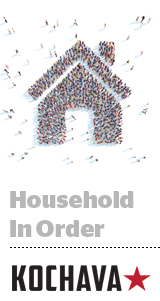 As if cross-device wasn’t complicated enough, there’s another wrinkle to consider – shared apps.
As if cross-device wasn’t complicated enough, there’s another wrinkle to consider – shared apps.
That’s one of the problems mobile analytics company Kochava is looking to tackle with Wednesday’s launch of Audience Attribution, a toolset aimed at identifying incremental attribution lift at the household level.
Existing Kochava customer Priceline and others, including a well-known subscription video company, are both using the solution.
At base, it’s a matter of giving credit where credit is due, said Kochava CEO Charles Manning.
“The reality is that there are incremental lift installs happening in households, but there’s no notion of household LTV [lifetime value] like there is singular-device LTV,” Manning said.
In other words, a single-device ID connected to a single device doesn’t necessarily capture the nuance of how an ad served on one device impacts other members of a cohort, household or other related group.
Kochava’s approach combines a deterministic solution on one side with a probabilistic one on the other.
In the first case, Kochava associates hashed internal customer IDs – say, a Netflix ID – with a Kochava device ID. From there, the advertiser can connect its CRM and web analytics data with customer behavior across devices within Kochava. This process lets clients link single mobile devices or several mobile devices within particular customer groupings, a family, for example, or a married couple.
Kochava is also using proximity to bolster connections between groups of people and their multiple devices based on their location. According to Manning, advertisers can use that information to streamline their acquisition spend. If Kochava can identify that a power user or influencer within a group, Mom, for example, has already downloaded a particular app, the advertiser can focus its budget on reaching completely new households rather than shelling out to reach other members of a household who will likely either share their login with each other or download the app on their own because they’ve already been exposed to it.
In the past, that reflected exposure would probably have been attributed to an organic install, even though it was influenced by a paid effort, Manning said.
“There are an awful lot of organic installs that are not necessarily organic,” he said. “Marketers don’t have the visibility to give credit across all media sources.”
Ad networks, which live or die based on performance, are in the same boat – and it’s impacting their bottom line.
“There are ad networks out there that are doing a valiant job of promoting an app, but they’re only getting credit for the work they’re doing if the device where the ad shown is also the device that installs the app,” Manning said. “An ad network’s entire job is judged on performance, and if they’re not looking at the wider net of audience being impacted, it doesn’t serve them well.”
Rather than competing with cross-device players like Tapad and Drawbridge, both of which are Kochava partners, Manning sees their respective methods as complementary to Kochava’s vision. Whereas much of their value prop is around serving media across devices, Kochava’s centers on attributing credit to those various media sources within the same audience..
“There are many different angles of attack to a common problem, but we’re all pointing at the same object,” said Manning, who noted that Kochava is integrated with around 1,300 publishers and ad networks, including Tapcommerce, Facebook, Google and Pandora. “Our position is that we have the provide the same delivery of attribution to advertisers irrespective of the sources they use.”











